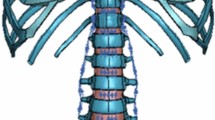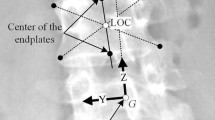Abstract
Studies have shown that scoliosis curves correct when patients are positioned on the operating table prior to instrumentation. However, biomechanical aspects of positioning have not been widely studied. The objective of this study was to simulate patient positioning during instrumentation surgery and test various adjustment parameters of the trunk and recommend optimal patient positioning prior to, and during spine surgery based on the results of finite element simulations. A scoliotic patient was simulated using a finite element model and six different positioning parameters were modified while ten geometric measures were recorded. Statistical analysis determined which model parameter had a significant effect on the geometric measures. Geometric measures were individually and simultaneously optimized, while corresponding model parameters were documented. Every model parameter had a significant effect on at least five of the geometric measures. When optimizing a single measure, others would often deteriorate. Simultaneous optimization resulted in improved overall correction of the patient’s geometry by 75% however ideal correction was not possible for every measure. Finite element simulations of various positioning parameters enabled the optimization of ten geometric measures. Positioning is an important surgical step that should be exploited to achieve maximum correction.


Similar content being viewed by others
References
Aubin CE, Descrimes JL, Dansereau J et al (1995) Geometrical modelling of the spine and thorax for biomechanical analysis of scoliotic deformities using finite element method. Ann Chir 49(8):749–761
Aubin CE, Petit Y, Stokes IAF et al (2003) Biomechanical modeling of posterior instrumentaiton of the scoliotic spine. Comput Methods Biomech Biomed Eng 6(1):27–32
Majdouline Y, Aubin CE, Robitaille M et al (2007) Scoliosis correction objectives in Adolescent Idiopathic Scoliosis. J Pediatr Orthop 27(7):775–781
Beausejour M, Aubin CE, Feldman AG, Labelle H (1999) Simulation of lateral bending tests using a musculoskeletal model of the trunk. Ann Chir 53(8):742–750
Behairy Y, Hauser D, Hill D et al (2000) Partial correction of Cobb angle prior to posterior spinal instrumentation. Ann Saudi Med 20:398–401
Carrier J, Aubin CE, Trochu F, Labelle H (2005) Optimization of rib surgery parameters for the correction of scoliotic deformities using approximation models. J Biomech Eng 127:680–691
Carrier J, Aubin CE, Villemure I, Labelle H (2004) Biomechanical modelling of growth modulation following rib shortening or lengthening in adolescent idiopathic scoliosis. Med Biol Eng Comput 42:541–548
Clin J, Aubin CE, Labelle H (2007) Virtual prototyping of a brace design for the correction of scoliotic deformities. Med Biol Eng Comp 45(5):467–473
Dar FH, Meakin JR, Aspden RM (2002) Statistical methods in finite element analysis. J Biomech 35:1155–1161
Delorme S, Labelle H, Poitras B et al (2000) Pre-, intra-, and postoperative three-dimensional evaluation of adolescent idiopathic scoliosis. J Spinal Disord 13:93–101
Delorme S, Petit Y, de Guise JA et al (2003) Assessment of the 3D reconstruction and high-resolution geometrical modeling of the human skeletal trunk from 2-D radiographic images. IEEE Trans Biomed Eng 50(8):989–998
Descrimes JL, Aubin CE, Boudreault F et al (1995) Modelling of facet joints in a global finite element model of the spine: mechanical aspects. Three dimensional analysis of spinal deformities. IOS Press, Amsterdam, pp 107–112
Desroches G, Aubin CE, Sucato DJ, Rivard CH (2007) Simulation of an anterior spine instrumentation in adolescent idiopathic scoliosis using a flexible multi-body model. Med Biol Eng Comput 55(8):759–768
Duke K, Aubin CE, Dansereau J, Labelle H (2005) Biomechanical simulations of scoliotic spine correction due to prone position and anaesthesia prior to surgical instrumentation. Clin Biomech (Bristol, Avon) 20:923–931
Duke K, Dansereau J, Labelle H et al (2002) Study of patient positioning on a dynamic frame for scoliosis surgery. Stud Health Technol Inform 91:144–148
Garceau P, Beausejour M, Cheriet F et al (2002) Investigation of muscle recruitment patterns in scoliosis using a biomechanical finite element model. Stud Health Technol Inform 88:331–335
Gignac D, Aubin CE, Dansereau J, Labelle H (2000) Optimization method for 3D bracing correction of scoliosis using a finite element model. Eur Spine J 9:185–190
Ghista DN, Viviani GR, Subbaraj K et al (1988) Biomechanical basis of optimal scoliosis surgical correction. J Biomech 21(2):77–88
Grealou L, Aubin CE, Labelle H (2002) Rib cage surgery for the treatment of scoliosis: a biomechanical study of correction mechanisms. J Orthop Res 20:1121–1128
Jeffries BF, Tarlton M, De Smet AA et al (1980) Computerized measurement and analysis of scoliosis: a more accurate representation of the shape of the curve. Radiology 134:381–385
King HA, Moe JH, Bradford DS, Winter RB (1983) The selection of fusion levels in thoracic idiopathic scoliosis. J Bone Joint Surg Am 65:1302–1313
Labelle H, Aubin CE, Dansereau J et al (2005) Dynamic frame for prone surgical positioning. US Patent 6,941,951
Lafage V, Dubousset J, Lavaste F, Skalli W (2004) 3D finite element simulation of Cotrel-Dubousset correction. Comput Aided Surg 9:17–25
Lenke LG, Betz RR, Clements D et al (2002) Curve prevalence of a new classification of operative adolescent idiopathic scoliosis: does classification correlate with treatment? Spine 27:604–611
Lenke LG, Betz RR, Harms J et al (2001) Adolescent idiopathic scoliosis: a new classification to determine extent of spinal arthrodesis. J Bone Joint Surg Am 83-A:1169–1181
Marsicano JG, Lenke LG, Bridwell KH et al (1998) The lordotic effect of the OSI frame on operative adolescent idiopathic scoliosis patients. Spine 23:1341–1348
O’Brien MF, Kuklo TR, Blanke KM, Lenke LG (2004) Spinal deformity study group: radiographic measurements manual. Medtronic Sofamor Danek, USA
Perie D, Aubin CE, Petit Y et al (2003) Boston brace correction in idiopathic scoliosis: a biomechanical study. Spine 28:1672–1677
Perie D, Aubin CE, Petit Y et al (2004) Personalized biomechanical simulations of orthotic treatment in idiopathic scoliosis. Clin Biomech 19:190–195
Peterson MD, Nelson LM, McManus AC, Jackson RP (1995) The effect of operative position on lumbar lordosis. A radiographic study of patients under anesthesia in the prone and 90–90 positions. Spine 20:1419–1424
Petit Y, Aubin CE, Labelle H (2004) Patient-specific mechanical properties of a flexible multi-body model of the scoliotic spine. Med Biol Eng Comput 42:55–60
Relton JE, Hall JE (1967) An operation frame for spinal fusion. A new apparatus designed to reduce haemorrhage during operation. J Bone Joint Surg Br 49:327–332
Schonauer C, Bocchetti A, Barbagallo G et al (2004) Positioning on surgical table. Eur Spine J 13(Suppl 1):S50–S55
Stokes IA (1994) Three-dimensional terminology of spinal deformity. A report presented to the Scoliosis Research Society by the Scoliosis Research Society Working Group on 3-D terminology of spinal deformity. Spine 19(2):236–248
Stokes IAF, Bigalow LC, Moreland MS (1986) Measurement of axial rotation of vertebrae in scoliosis. Spine 11(3):213–218
Tan SB, Kozak JA, Dickson JH, Nalty TJ (1994) Effect of operative position on sagittal alignment of the lumbar spine. Spine 19:314–318
Vedantam R, Lenke LG, Keeney JA, Bridwell KH (1998) Comparison of standing sagittal spinal alignment in asymptomatic adolescents and adults. Spine 23:211–215
Villemure I, Aubin CE, Dansereau J, Labelle H (2002) Simulation of progressive deformities in adolescent idiopathic scoliosis using a biomechanical model integrating vertebral growth modulation. J Biomech Eng 124:784–790
Villemure I, Aubin CE, Dansereau J, Labelle H (2004) Biomechanical simulations of the spine deformation process in adolescent idiopathic scoliosis from different pathogenesis hypotheses. Eur Spine J 13:83–90
Acknowledgments
This study was funded by the Natural Sciences and Engineering Research Council of Canada (Collaborative Research and Development Program with Medtronic Sofamor Danek). Special thanks to Geneviève Desroches and Archana Sangole for the revision of the manuscript.
Author information
Authors and Affiliations
Corresponding author
Rights and permissions
About this article
Cite this article
Duke, K., Aubin, CE., Dansereau, J. et al. Computer simulation for the optimization of patient positioning in spinal deformity instrumentation surgery. Med Bio Eng Comput 46, 33–41 (2008). https://doi.org/10.1007/s11517-007-0265-z
Received:
Accepted:
Published:
Issue Date:
DOI: https://doi.org/10.1007/s11517-007-0265-z




